#folk wisdom in its ceremonies
Text
Thai-style spa services
Thailand has been a consistent winner of several spa awards for many years. Thailand's spa sector appears to be in good condition, evolving with the changing needs of spa clients to a focus not far from the old goal of traditional Thai massage and herbal treatment techniques. Despite the necessity to integrate Western principles, the Thai spa industry's competitive advantage is its historic heritage: the rituals, treatments, and massage techniques that have lasted the millennia.
It has an authenticity that spas throughout the world strive to emulate, and "Thainess" has also become a key marketing factor for Thai spas. It is critical to understand why Thai spas with Thainess or in Thai style have won numerous accolades and surprised the globe!
Thainess refers to both the therapists and the cultural characteristics that have made Thailand the spa capital of the Asia-Pacific region and a must-have component for spas worldwide. While Thainess might mean different things to different individuals, it appears to encompass old therapeutic procedures, folk wisdom in its ceremonies, and, probably most importantly, graciousness when applied to Thai therapists.
Maintaining wellbeing through a better balance of the body, mind, and spirit, as well as with the environment, has become a fundamental principle for Thailand's award-winning spas and new initiatives. Thailand is increasingly positioned as a medical destination offering both orthodox and alternative treatments.
Thailand, known as the "Land of Healthy Smiles," offers its health and beauty-conscious visitors the wonders of pampering and holistic spa treatments for the body, mind, and spirit. The discovery of health and wellness includes a comprehensive selection of world-renowned day spas, destination spas, hotel/resort spas, and medical spas.
Spa treatments in Thai style can help you connect with your inner self in a variety of locations across the country. A Thai spa is unquestionably a worthwhile treat that gives the best spa experience. Without a doubt, this causes discerning tourists and receivers to fall in love with Thai spas with Thainess or in Thai style!
Thailand is a world-class spa destination because of its delicate blend of cultural heritages and diversities. Thai spas, with a focus on health and beauty, incorporate methods of relaxation and health enhancement, both physically and spiritually.
They bloom in Bangkok and key tourist cities around the country. The Thai spa experience incorporates indigenous resources, unique traditions, and local wisdom that have been passed down through the generations. Recognizing potential market niches for spa business, spa operators look to this historic treasure trove to produce and showcase the greatest Thai style spas to ensure worldwide spa recipients a lasting spa expectation.
In truth, Thailand's spa treatments differ greatly from those provided at top spa facilities across the world because the spa theory there has been embraced and adapted into traditional Thai style. The globe has been impressed by an imported spa recipe with a distinctive Thai twist! Spa facilities in Thailand also are of premium and exceptional value for money.
A tropical sanctuary with natural and cultural diversity, Thailand is regarded one of the world's most recognised holiday resorts. This is a great plus that helps strengthen the country's basic strength as an eternal spa paradise. Additionally, top-notch spa supplies give foreign spa visitors a fresh perspective and a sense of familiarity.
Thai spas give visitors the chance to experience several aspects of traditional Thai culture. Thai spa experiences stand out because the staff members are innately friendly and service-oriented. The kindheartedness and gentleness of the Thai people compliment gracious hospitality and high-quality service, adding to the distinctive Thai touch's global recognition.
The Theravada Buddhist tradition strongly promotes kindness, compassion, and providing solace to others, and these virtues are deeply ingrained in daily life. The gesture is also logical and sincere. Additionally, the majority of spa facilities are built with distinctively Thai features that are highly regarded among foreign visitors.
The Land of Healthy Smiles, which offers a wide range of spa services, has also developed a wide range of retreats, alternative therapies, one-on-one consultations, and life coaching. Traditional Thai, Swedish, Javanese, and Sports massages, foot reflexology, aromatherapy, acupuncture, acupressure, hydrotherapy, skincare services including body wraps and facial scrubs, treatments for the face, skin, and hair, herbal steams, and floral baths are all frequent offerings at Thai spas.
Along with healthy nutrition and detoxifying, the Thai spa experience also includes body and mind exercises like yoga, tai chi, pilates, stress management, holistic wellbeing, and spa cuisine. Thai spas are well-known throughout the world thanks to its holistic therapies. The therapeutic properties of Thai herbs and plants that have been particularly designed to rebalance, repair, and revitalise the body, mind, and spirit are the foundation of many healing methods, holistic treatments, and wellbeing programmes.
#Land of Healthy Smiles#Massage san antonio#spa#couple#Thailand has been a consistent winner of several spa awards for many years. Thailand's spa sector appears to be in good condition#evolving with the changing needs of spa clients to a focus not far from the old goal of traditional Thai massage and herbal treatment techn#the Thai spa industry's competitive advantage is its historic heritage: the rituals#treatments#and massage techniques that have lasted the millennia.#It has an authenticity that spas throughout the world strive to emulate#and “Thainess” has also become a key marketing factor for Thai spas. It is critical to understand why Thai spas with Thainess or in Thai st#Thainess refers to both the therapists and the cultural characteristics that have made Thailand the spa capital of the Asia-Pacific region#it appears to encompass old therapeutic procedures#folk wisdom in its ceremonies#and#probably most importantly#graciousness when applied to Thai therapists.#Maintaining wellbeing through a better balance of the body#mind#and spirit#as well as with the environment#has become a fundamental principle for Thailand's award-winning spas and new initiatives. Thailand is increasingly positioned as a medical#Thailand#known as the offers its health and beauty-conscious visitors the wonders of pampering and holistic spa treatments for the body#and spirit. The discovery of health and wellness includes a comprehensive selection of world-renowned day spas#destination spas#hotel/resort spas#and medical spas.#Spa treatments in Thai style can help you connect with your inner self in a variety of locations across the country. A Thai spa is unquesti#this causes discerning tourists and receivers to fall in love with Thai spas with Thainess or in Thai style!
1 note
·
View note
Text
Visitor from the Sea of Sand, Profound Providence
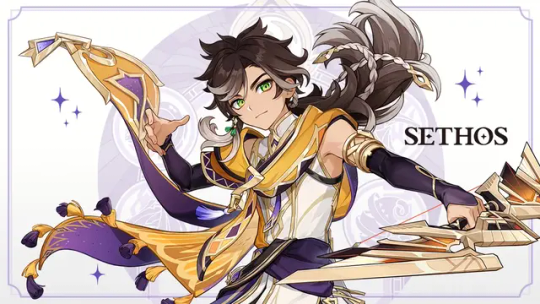
"You shall have the dexterity of the fox and the agility of the flying serpent. The wisdom of Hermanubis shall also bestow its favor upon you. Your name shall be Sethos."
— A divination from a Priest during a name-giving ceremony
◆ Name: Sethos
◆ Title: Wisdom's Measure
◆ Desert Envoy
◆ Vision: Electro
◆ Constellation: Basileos Delta
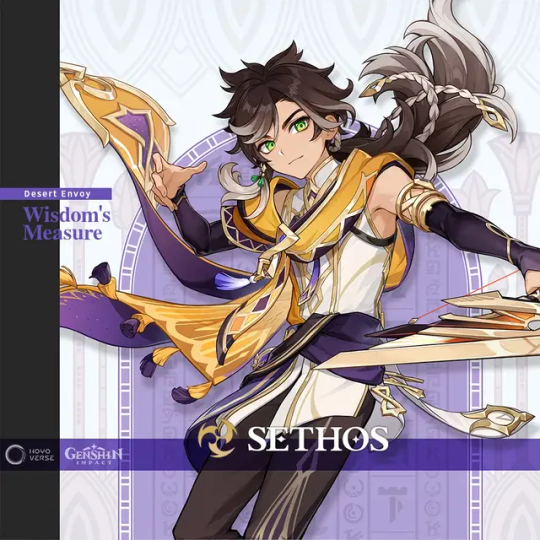
Inexperienced travelers often find themselves trapped by the vast, boundless sea of sand. Were it not for the timely guidance of a kind soul, their journey of exploration might have come to an untimely end, cruelly cut short. Many of those who were lost and returned to their companions on the road all had the same name upon their lips: Sethos.
A great sense of direction, enthusiastic and talkative... These are all common impressions among those who have been on the receiving end of Sethos's guidance. And it is quite true. As a desert-dweller, Sethos knows the paths between the various oases like the back of his hand, and his mastery of the techniques of navigation — such as using the sun's position to calculate direction — runs even deeper. As a personal interest, Sethos enjoys traveling by foot between desert and rainforest, and the navigational skills he's acquired are a product of his personal experiences doing so. As for being enthusiastic and talkative, by speaking with Eremites chance met on the road or listening to the fascinating anecdotes of hapless scholars rescued from swamp and marsh, not only can he broaden his knowledge and horizons, but also have a lot of fun. For Sethos, that is where the joy of the journey lies.
Perhaps it is because of this personality of his, but regardless of locale, from desert to rainforest, he always has those he can regard as friends. One researcher he met at Caravan Ribat, who had developed a deep admiration for Sethos after being struck by his distinctive understanding of the Akademiya and its knowledge system, once even went so far as to suggest that Sethos sit the Akademiya's entrance exam.
"Be a student at the Akademiya? It would be pretty fun to see how the Akademiya's teachings differ from what the old folks say back home. I'll consider it."

#genshin impact#genshin impact updates#genshin impact news#official#sethos#JUMPSCARED#i thought it was just clorinde and sigewinne
921 notes
·
View notes
Text
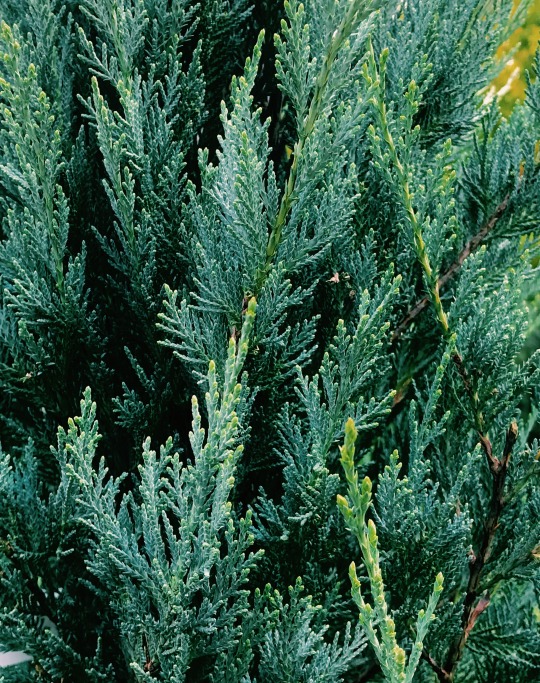
Eastern Red Cedar (Essential Herbs for Witches)
*Notes from the Hekate ritual kits that were released October 23'.
Latin name: Juniperus virginiana
Planet: Sun, Saturn
Element: Fire
Parts used: foliage, wood, essential oil
Astrological Association: Leo
Energy: Masculine
Magical properties: Longevity, protection, preservation, strength, wisdom, perseverance, renewal, transformation, balance, connection to the divine through nature, return of stolen goods, defense.
Healing properties: Fever, cough, skin conditions, respiratory issues
Eastern Red Cedar is not actually a true cedar, it’s a juniper, as its latin name, Juniperus virginiana, indicates. Naturalized in Europe, Asia, and North America, Eastern Red Cedar is present in all temperate regions of the northern hemisphere and stretches into parts of the southern hemisphere. This hardy tree has deep roots and tolerates poor rocky soil, salt, heat, and wind, and is drought tolerant.
Medicinally juniper has been used in bathing, sometimes as a scourge, to alleviate rheumatoid arthritis and to relieve depression symptoms and exhaustion. It’s also been used to heal open wounds. Juniper is warming and pungent and affects the liver and kidneys. Its bitter action stimulates the gallbladder and liver and it aids in digestion. Juniper is also used for respiratory issues, urinary tract infections, and skin ailments like psoriasis and eczema. The warming effect of juniper makes it helpful in breaking fevers. Eastern red cedar is an abortifacient and should not be used by pregnant women.
Juniper berries have been used to flavor food, beer, and notably gin, and in Ireland the unripe berries are tinctured with whiskey and used as a general health tonic.
As for juniper’s use in folklore and witchcraft, around the Mediterranean and Aegean seas, it was planted to protect a home from evil spirits and malicious men. It was sometimes built into a new house as a structural beam or to fill cracks between stone to drive away illness and evil spirits. Branches were hung above doors to repel witches.
Because it is an evergreen, it’s also used in fertility rites and the berries are sometimes used as an aphrodisiac.
Shamans in Siberia burned and inhaled the smoke of juniper to induce trance, and because of its high thujone contain, it can indeed induce altered states. Thujone does build in the liver over time so care should be taken to limit smoke inhalation to occasional use.
Burning juniper as a smudge was common in Native American rituals for purification and to cleanse sacred ritual space. Cherokee natives believed that the wood of this cedar held the spirits of their ancestors. In other native ritual practices, it was believed that messages were sent to the Creator when it was burnt ceremonially.
In Scottish folk magic, juniper is used to ‘sain’ livestock and homes during Beltaine and Samhain. Saining is done by lighting bonfires and driving cattle between them. These fires would be lit from sacred Neid fires and extinguished home fires would be relit with this fire. People also hopped over these fires to rid themselves of negative spirits. Juniper (lubhar beinne) was used, and to a lesser extent, mountain ash or rowan (caorran). The cattle byre was sained, and the lintel over the byre was anointed with wine or human urine. Homes were also sained with burning juniper and “in such quantities to fill the whole house with smoke.” Juniper would have also hung at windows to ward off witches and evil spirits and to rid the house of pests and diseases.
According to Scottish folklore, juniper needed to be harvested in a particular way, like all magical plants. It was pulled by the roots, taking 4 branches between 5 fingers while an incantation was repeated. Today we should probably refrain from yanking bushes from the ground and taking a branch or some berries after asking permission should suffice. The branches can be dried and burned or the berries can be burned on a charcoal disc, or dip the branch into sea salted water and sprinkle a bit on yourself and your magical working space.
While we generally think of juniper as a plant of the Sun, it does have older Saturnian associations perhaps because they are very long lived, but maybe also because of their often gnarled wood and spiky foliage, giving them a dark, ominous aspect. Like both yew and cypress trees, Easter red cedar is common in older cemeteries in the southern united states. This may be because its evergreen leaves have come to symbolize ‘eternal life’, but through the ancient Greeks, we have an association with juniper as a plant of Hekate, perhaps because she led the procession of the dead. Through Hekate, it is also associated with Medea, a Hekatean priestess.
I choose to substitute Eastern red cedar for the yews, cypress, and cedar we traditionally see aligned with Hekate because ERC happens to grow in abundance in my bioregion and has a long history of use in sacred rites across the world. Eastern red cedar is a plant of protection and is excellent for banishing, inspiring courage and strength, purification and release.
16 notes
·
View notes
Text
Estonian ghost stories and folklore
Estonia, with its rich folklore and history, has its share of ghost stories and supernatural legends. Here are a couple of Estonian ghost stories:
The White Lady of Haapsalu Castle: Haapsalu Castle is one of Estonia's most famous historical sites. It's said to be haunted by the White Lady, a ghostly apparition of a noblewoman who died in the castle. She's often seen wandering the corridors and looking out the window
The Flying Dutchman of Vormsi Island: Vormsi Island is known for its maritime history. According to local legend, the ghostly ship of the Flying Dutchman has been spotted around the waters of the island. The spectral ship is said to be a harbinger of storms and bad luck for sailors.
The Church Ghost of Pühalepa: In the village of Pühalepa on Hiiumaa Island, there's a story of a ghostly churchgoer. People have reported hearing footsteps and seeing an apparition in the local church. The ghostly figure is said to be a woman who continues to attend services in the afterlife.
The Cursed Bell of Pöide Church: Pöide Church, located on Saaremaa Island, has a cursed bell. According to legend, the bell was stolen by pirates, and a curse befell those who took it. The bell was eventually returned, but its haunting toll can still be heard at times.
The Devil's Wedding in Vana-Vigala: In Vana-Vigala, there's a legend about a sinister event known as the Devil's Wedding. It's said that every year, the devil himself and all his underlings gather for a macabre wedding ceremony. Anyone who stumbles upon this eerie event may meet a terrible fate.
Estonian folklore is a rich and diverse tapestry of legends, myths, and traditional beliefs that have been passed down through generations. Here are some key aspects of Estonian folklore:
Nature Spirits: Estonian folklore is deeply connected to nature, and various spirits and creatures are believed to inhabit the forests, lakes, and meadows. These include the spirits of trees, water nymphs, and forest elves. It's common to see an appreciation for nature's beauty in Estonian folk tales.
Mythical Creatures: Folklore is filled with mythical creatures, such as the "kratt" or "krabat," which is a supernatural being created through a pact with the devil. Kratts were often used to perform various tasks but could be mischievous and hard to control.
The Kalevipoeg Epic: Estonia's national epic, "Kalevipoeg," is a heroic poem that's often compared to the Finnish epic "Kalevala." It tells the tale of Kalevipoeg, a hero with extraordinary strength, and his adventures in ancient Estonia. The epic is a treasure trove of Estonian mythology and cultural heritage.
The Night of Ancient Lights: "Muistse Valguse Öö" is a tradition in which people gather on the summer solstice to celebrate and connect with ancient Estonian customs. It's a time of bonfires, singing, and paying homage to the country's historical roots.
Runo Songs: Estonia has a strong tradition of runo songs, which are short, rhyming folk songs. These songs are often used to pass down stories and wisdom through music and poetry. The "regilaul" tradition of singing runo songs was recognized by UNESCO as a masterpiece of oral and intangible heritage of humanity.
The Legend of the Saaremaa Women: One popular Estonian legend tells the story of the strong and independent women of Saaremaa, an island off the western coast of Estonia. According to the legend, the men were often away at sea, so the women had to manage the farms and households. This legend reflects the historical role of women in Estonian society.
Witches and Magic: Like many European cultures, Estonia has a tradition of witches and folk magic. Witches, both good and evil, are recurring characters in Estonian folklore. The country's forests and bogs are often depicted as places of magic and mystery.
Estonian folklore is an essential part of the country's cultural identity and has played a role in shaping its national character. It's a world of enchanting stories, mythical creatures, and a deep connection to the land and nature.
All of the explanations I write about may end up being in my book, so when it's completed you can look out for these elements.
#writers on tumblr#writing#writeblr#writers and poets#writerscommunity#writer things#writerblr#books#adventure#unexplained#ghost story#ghost ghouls#ghost hunter#ghost hunting#ghost stories#ghosts#got ghost#ghost#nameless ghouls#estonia#folklore#eras
34 notes
·
View notes
Text
It is typical of genuine Cunning-folk to utilize whatever is closest at hand and to turn all influences, irrespective of religious provenance, to the secret purposes of the Arte. It is therefore that the Old Craft embraces for itself an array of attitudes and methods, ranging from the simple matters of spell-craft to the highest ceremonial forms of conjuration; in all contexts one may find pieces of magical lore and belief from many disparate times and places, but all are brought to function within the trans-historical arena of the sacred dimension […] From out of its roots in folk magic, in all of its many aspects, the form of the Traditional Craft is continually evolving, and it is in this respect that one may perceive the trajectories of its own possibilities. The spiritual landscape of the Arte is being molded, through the power of its own current, by a potent aesthetic of mythopoetic eclecticism; its rich variety of ancestral lore is achieving a new definition of form, culminating in the refinement of a profound metaphysic of ecstasy: The true wisdom-teaching of magical gnosis.

From 'What is Traditional Craft: A Brief Discourse Regarding the Nature of Traditional Witchcraft and Allied Forms of Magical Practice'; Andrew Chumbley (My Ko-Fi Here)
#What is Traditional Craft: A Brief Discourse Regarding the Nature of Traditional Witchcraft and Allied Forms of Magical Practice#Andrew Chumbley#Traditional Witchcraft#Sabbatic Craft#Cultus Sabbati#The Crooked Path#TradCraft#Quote
10 notes
·
View notes
Text
TL;DR i got a spotify recommendation for podcast about """""Toltec philosophy""""" sponsored by a huge pawnshop chain, IMMEDIATELY smelled bullshit and clocked a full on made-up-yoga cult for wealthy whitexicans within minutes.

Okay so first off the Toltecs may have been one of the most influential cultures in Mesoamerica or... not a thing at all lol
youtube

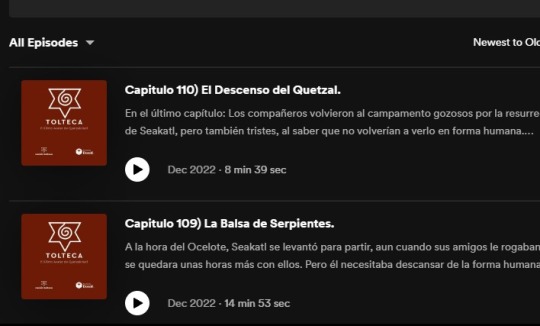
100+ episodes… no names or faces, only the pawnshop folks' icon and 'TOLTECA NATION'?
Like. Listen. A moneylending chain with 400 locations in this country HAS TO be a mafia and integrated into narco-govt cartels in order to exist.
And then on their website there is this!!!
WE ARE ALL QUETZALCOATL
At Fundación Dondé we are convinced that the greatness of Mexico is in its Civilization Legacy of more than 8,000 years; We proudly exalt this Legacy and we aim to share it so that more and more Mexicans know it and feel proud of who they are.
The history of Mexico is much bigger than what they taught us; Toltec Nation is an educational initiative to rescue the Toltec legacy of Anahuac (Territory of which Mexico is now a part) and to publicize the foundations and principles of Toltequity as a philosophy of life, as well as to propose a feasible response to contemporary challenges.
TOLTEC NATION
EDUCATION AND ACTION
From this wisdom of ours, we seek to move to support our communities, keep their traditions alive, recognize their languages (68 today spoken in Mexico!), know-how, the environment, and reconnect with a more conscious Mexico.
Our field of action is comprehensive, in addition to spreading the story, we rescue an ancient physical practice based on the Toltec positions of power called KINAM. To start practicing visit Agoralucis.

the alleged 'tOlTeCa nAtIoN' is just... their own org?? Like a subdivision of the pawnshop corp? Sure smells like some whitexican / corpxican self legitimising HorseShit & not an organic endeavour by indigenous ppl. And now they mention a new agey cult sounding name w/ no added context, just, like, "look em up if you really wanna". so I did! lol

Glorious. Really digging the space glitter background on the lady who claims to cure hypertension, DIABETES AND CANCER by just, like, BREATHING RIGHT, DUDE! TRULY TUBULAR
DSLKDJFSSJDKLSFJ
Anyway. the shit we were looking for is right after her in the carousel

Some certified whitexican flavor... anddddd
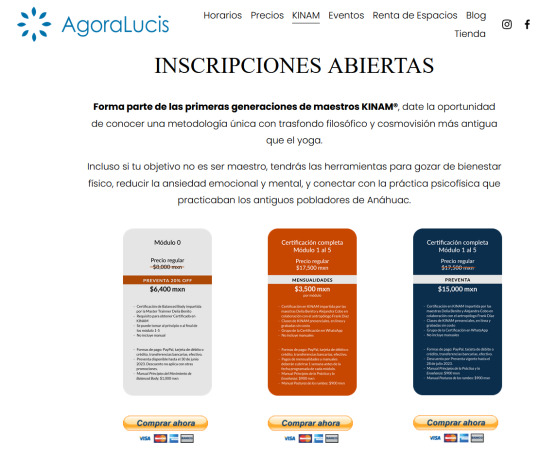
THERRRRRE WE GO! Give us 400-800 USD to become a Certified Instructor of Totally Real NonYoga (which btw is OLDER THAN YOGA!!!!1!111!)


In, predictably, a huge fuckoff space nestled in one of the peak "Rich Pieceoshit" parts of town, decked out in full "cult chic" blindingly white decor

Or you can get the vacation package! That includes:
"3 days and 2 nights of lodging. Food, drinks and snacks, 2 temazcales, cocoa ceremony, 1 practice of KINAM daily, meditations, breathing techniques, NAHUALIC TECHNIQUES, talk about toltequity and dance five elements"
---
Eventually, I hit the motherlode, a blog with glorious "2000s lunatic" aesthetic and deranged contents to match

I MEAN......
The title goes: "WIZARDS TURN BACK TIME - TOLTECA SCHOOL"
The stuff in the caption is "The wizards' secret is that they know time can be manipulated. For example IT IS POSSIBLE TO REVERT THE EUROPEAN INVASION OF AMERICA."
I SURE FUCKING WISH IT WAS, JULIO, BUDDY!!! MAYBE THAT WAY YOU & THE SHIT YOU PEDDLE COULD'VE BEEN AVERTED 💀💀💀
There's also a video of a talk the guy gave at the fancy schmancy yoga place, but he apparently usually does events along... Crunchier lines, graphic design and location-wise:

The events apparently emphasise the PROPHETIC ASPECTS of sacred maya & nahuatl literature 💀 and the "CEACM", the "Center for Archaeoastronomic and Calendaric Studies of Mesoamerica", is populated by Grifters Galore alongside our deranged friend Julio

"SCIENTIFIC ADVISER" SURE 💀

And finally... a post where he rages against the horrible terrible no-good "ONLY FAKE RETIRED EX-NAHUAL" who exposed their bullshit:

"At this web address, the only retired fake nagual that exists in Mexico makes a series of malicious, defamatory and insulting comments about me and some friends, especially Master Frank Díaz. The title says it all: "a sect destroyed". The funny thing is that there has never been a kinam sect, so you can't destroy something that doesn't exist. This leads me to consider that being the product of the sick imagination of this guy, he really IS the creator. So then you could believe that now it is "destroyed". A creator can destroy his work as many times as he wants."
the giiiirls arrrrrre FIGHTINNNNGGGGGGGGG!!!
---
So we have a happyish ending: this shit is sooo fucking shameless and out in the open that there is already a pretty great, comprehensive site exposing it. It looks like they're only parting goofy ass whitexicans incapable of googling with their money, so not as bad as it could be.
The site is here ( https://kinam.org/ ) and it's SUCH a gem lmao:

TITLE: Kinam: Chronicle of a Destroyed Sect
MENU: (including this bc it's hilarious trust me)
Start
The Impossible Toltec Yoga
Consequences
Contact
The other Kinam
FAQ
Faith of Facts
New Fire
Gallery
Loud and rude 😹😭
Legal
Links
GALACTIC MAYANS
More about
Summary
Sustained Reaction – Funny Interview
Sustained Thread
Notice of Privacy
"Summary 2017 : Julio Diana, a Uruguayan, tried to sell courses to a circle of friends with a good economic level, but when he was rejected, he and his partner Frank Diaz created the KINAM sect. This sect affirms that the world has been under an extraterrestrial attack led by Tezcatlipoca for two million years. The sect also speaks of spiritual dimensions, that the Olmecs are Toltecs and Julio Diana claims to be the current exponent of another sect called Linaje1723 founded 5000 years ago. The KINAM sect has been destroyed, but its founders still try to promote their vacillates using aliases."
It goes on a little bit and includes links to proof & shit...
---
TRULY I feel invigorated, amused, entertained beyond measure. I fucking love rabbit holes into silly cults, especially when nobody dies (that I know of? also this whole post is like. Allegedly™, In Minecraft™, none of this happened for real 😊).
i'm....................... need a drink after this lol
#viitalks#LONG ASS POST warning#like... i want a podcast about THIS SHIT#not the cringefail ad for the cult's expensive ass certifications & courses & vacations & shit#lindo y jodido#ñposting
4 notes
·
View notes
Text
05. meet the cast (pt. 1)
The Company: a traveling mortuary company that provides services for both hire and charity. Some of their services include, but are not limited to: corpse preparation, funeral ceremonies, headstone design, coffin crafting, memento mori commissions. Their mode of travel is this really peculiar hearse caravan.
The idea of The Company came about in part because I had read somewhere that some cowboys were buried with custom designed cowboy boots to be placed by their graves – then I wondered, what about all the folks that were left alone in the wild and are left alone to just perish? Or what about in settlements that don’t really have an undertaker or formal funeral company to help one of their own? Everyone ought to be sent off, remembered. My initial thought was that it would be cool to have a specific company/group that travels the West that specializes in cowboy burials – memento mori pieces, custom headstones things, burials etc. Then, during that time where I was trying to pivot to a more gothic-fantasy-western sort of direction, I thought the idea of this company would be so freaking cool. They would be the in-betweeners of the “monsters” vs. “hunters” in this universe, and be associated with all things Death. Soul senders? Collectors? Ditto if I have totally written that off yet hmm.
Anyways! I’m still flushing out the members of The Company, but so far, I’ve sketched out enough to formulate a group of four individuals. These folks share a deep and respected relationship with death/death culture. Their “titles” only highlight their role of expertise within The Company’s services, but they are more than capable of intersecting and assisting each other when needed. Folks!!! I introduce you to:
Rupert Fritz Worth, The Surgeon with an eclectic taste in fashion and curio collections. Has been suspected of time travel on three separate occasions—both in America and in the Austrian Empire. Like many other professionals in the field, he began as a barber, specifically impressive facial hair styling, until necessity and opportunity brought him into medicine.
Ed McCullen, The Carpenter shyer around the living than the dead. Though he can handle the sight of blood and rotting flesh so much as a flinch, the idea of engaging in small talk with a stranger is enough to make his stomach hurt. Feels safe in the shadows of his friends. Whittling is something that helps to calm and ground him as well. He has quite the collection!
Dara Quinn, The Undertaker leading The Company and all of its business matters. Between managing finances, organizing funeral services, and meeting with patrons, they have taken up in learning about the occult. It’s partly out of curiosity and partly out of an amusement of people’s peculiar devotion to the supernatural—if it’s so popular, it must be real, right? They love a good mystery, and nothing is more mysterious than things you can’t see or control.
Chester Reeves, The Reverend who is impressively handy with a gun. Was he naturally skilled? Or did his profession call for him to learn how to handle firearms? His past has greatly shaped his views on life, fate, and death. Insists that he is less of a profound speaker than an accidental philosopher when he unintentionally drops words of wisdom.
Delfina “Della” Rivera, The Chemist with a keen talent for brewing. Tonics, moonshine, balms, perfume, poison—you name it, she can make it. She had no interest in profiting from her creations, content with experimenting new recipes and sharing with others she meets When she isn’t buried in her chemistry kit, she assists Rupert with embalming and dressing of corpses.
#the daywalkers#ocs#writing#writeblr#cowboy fic#western fic#wip#update#update: characters#the company#rupert worth#ed mccullen#della rivera#death cw#chester reeves#dara quinn
3 notes
·
View notes
Text
LORE OF - The Valley of Luck
I have a patreon that I post behind the scenes and extra goodies on
There are gods that are worshiped in the land of Aerethae, They have been known by many names, "The nines above" "The divine nine" "The thrones of the Aether" or simply and most commonly,-
The Nine
Luphrie- This deity is said to represent love, fertility, and change. Representative of the first half of agriculture, to sow and to nurture, they are the spring and summer
Illumae- This goddess represents light, dark, colour, and emotion. As such, she tends to be considered the goddess of the arts
Drekah- the goddess of dragons, she represents the gift of wisdom, intelligence, and the pursuit of knowledge.
Queezol- deity of flight, wind, and weather, depicted as a flying serpent-like being with the face of a fox with several multi-coloured wings. Part of the trio of nature, the air.
Oomi- Deity of the sea, is said to be quite curious and playful and quite sociable. sailors who've come in contact with them have reported the undersides of their vessels to be covered with rabbit-like sea slugs. Part of the trio of nature, the sea.
Aldimr- The deity of the forest, is depicted as a being with the body of a stag with the head of a wolf. Those who possess a strong bond with nature feel empowered by its presence, those who do not feel intimidated at its power. Part of the trio of nature, the earth.
Zelasi- The goddess of death, and undeath, she is said to be the sister of Luphrie, she is depicted as having red threads keeping her body together, as such, most death ceremonies involve the deceased having red thread tied to their limbs, so when the deceased passes to the afterlife, they'll see the thread and realize that they are dead, and won't come back as spirits, thinking that they're still alive. Representative of the second half of agriculture, to reap and to harvest, they are the autumn and winter
Volloc- god of void, destruction, vengeance, and Justice. In ancient times, it is said that in war, if both sides would pray to him, both sides would be destroyed. It is said invoking Volloc is dangerous, because if your cause isn't justified in his eyes, he would make your thirst for vengeance destroy you, but if he deemed it justified, you would receive the justice you rightfully deserved.
Lucian- The God of luck and tricksters, currently the most worshiped god in all of the four continents, it is said back in ancient times, Lucian would walk among mortal folk and interact with them more than any other god, frequently drinking and playing tricks on them and is frequently referred to as "the god of bards and travelers"
6 notes
·
View notes
Text
Poetry of the People: Exploring Folk Traditions and Oral Poetry with Herve Comeau Syracuse
The history of poetry is rich and diverse, encompassing a wide range of traditions and styles. While much attention is often given to canonical works and renowned poets, it is important to recognize the significance of folk traditions and oral poetry in shaping the poetic landscape. Folk poetry, passed down through generations via oral tradition, offers a unique insight into the cultural heritage and collective experiences of communities around the world. In this blog, we will delve into the fascinating world of folk traditions and oral poetry with the help of poetry lovers like Herve Comeau Syracuse, exploring their origins, characteristics, and enduring relevance.
Origins of Folk Poetry
Folk poetry has its roots in the oral traditions of ancient civilizations, where poetry served as a means of preserving and transmitting cultural knowledge, history, and values from one generation to the next. From epic narratives and ballads to nursery rhymes and chants, folk poetry encompassed a wide range of forms and themes, reflecting the diverse experiences and perspectives of communities across time and geography.
Many folk poems originated in rural settings, where communal gatherings and social rituals provided opportunities for storytelling and performance. These poems were often composed and recited by ordinary people, drawing inspiration from everyday life, nature, and the collective imagination. Over time, folk poetry evolved and adapted to changing social and cultural contexts as mentioned by poetry buffs such as Herve Comeau Syracuse, reflecting the dynamic nature of human experience and creativity.
Characteristics of Oral Poetry
Oral poetry is characterized by its reliance on oral transmission and performance, rather than written text. Passed down through generations via word of mouth, oral poetry thrives in communities where storytelling, singing, and recitation are integral parts of cultural expression. Unlike written poetry, which is fixed in form and content, oral poetry is dynamic and fluid, adapting to the needs and preferences of performers and audiences.
One distinctive feature of oral poetry is its emphasis on rhythm, meter, and sound patterns, which contribute to its musicality and mnemonic qualities. Through repetition, rhyme, and alliteration, oral poets create memorable verses that are easy to remember and recite. Additionally, oral poetry often employs vivid imagery, symbolism, and metaphor to evoke emotions, convey meaning, and engage the senses of listeners. By harnessing the power of language and performance as noted by poetry enthusiasts including Herve Comeau Syracuse, oral poetry has the ability to captivate audiences and foster a sense of communal identity and belonging.
Global Folk Poetry Traditions
Folk poetry is a global phenomenon, with rich and diverse traditions found in cultures around the world. From the epic poems of ancient civilizations like the "Iliad" and "Mahabharata" to the ballads of medieval Europe and the lyrical verses of African griots, folk poetry reflects the unique cultural heritage and linguistic diversity of humanity. Each tradition has its own distinctive styles, themes, and performance practices, shaped by the historical, social, and geographical contexts in which they emerged.
Poetry lovers like Herve Comeau Syracuse convey that in many cultures, oral poetry plays a central role in religious ceremonies, rituals, and festivals, serving as a means of spiritual expression and community cohesion. In some societies, oral poets hold esteemed positions as custodians of cultural knowledge and wisdom, entrusted with the task of preserving and transmitting ancestral traditions to future generations. Despite the challenges posed by modernization and globalization, folk poetry continues to thrive as a vital form of cultural expression and resilience in communities around the world.
Revival and Preservation Efforts
In recent years, there has been a growing interest in reviving and preserving folk poetry traditions as a means of safeguarding cultural heritage and promoting intergenerational transmission of knowledge. Cultural organizations, educational institutions, and grassroots initiatives have undertaken efforts to document, archive, and disseminate oral poetry collections through various mediums, including recordings, publications, and digital platforms.
Additionally, there has been a resurgence of interest in traditional storytelling and performance practices, with festivals, workshops, and community events celebrating the rich tapestry of oral poetry traditions. These initiatives not only provide opportunities for practitioners to share their craft with wider audiences but also foster dialogue, collaboration, and cross-cultural exchange. By investing in the preservation and revitalization of folk poetry, communities can ensure that their cultural legacy continues to inspire and resonate with future generations.
Role of Folk Poetry in Cultural Identity
Folk poetry plays a crucial role in shaping cultural identity and fostering a sense of belonging within communities. Through the sharing of common narratives, symbols, and values, oral poetry reinforces cultural cohesion and solidarity among members of a community. By preserving and transmitting ancestral knowledge and traditions, folk poetry serves as a link between past, present, and future generations, anchoring individuals within their cultural heritage and providing a sense of continuity and connection.
Furthermore, folk poetry often serves as a form of resistance and resilience in the face of social, political, and economic challenges. In times of adversity, oral poets use their craft to express dissent, advocate for social justice, and celebrate the resilience of the human spirit. By giving voice to marginalized communities and challenging dominant narratives as highlighted by poetry buffs such as Herve Comeau Syracuse, folk poetry becomes a powerful tool for empowerment and social change.
Challenges and Opportunities in Preserving Folk Poetry
While folk poetry continues to thrive in many communities, it also faces challenges in the modern world. Rapid urbanization, globalization, and the erosion of traditional cultural practices threaten the survival of oral poetry traditions in some regions. Additionally, linguistic and cultural barriers, as well as the lack of institutional support and resources, pose obstacles to the preservation and transmission of folk poetry.
However, there are also opportunities for innovation and collaboration in the preservation of folk poetry. Digital technologies offer new avenues for documenting, archiving, and sharing oral poetry collections with a global audience. Collaborative efforts between scholars, artists, and community members can enrich our understanding of oral poetry traditions and ensure their continued vitality. By embracing these opportunities and addressing the challenges, we can work together to safeguard the rich legacy of folk poetry for future generations.
Folk poetry stands as a testament to the creativity, resilience, and cultural richness of humanity. From ancient epics to contemporary ballads, oral poetry traditions continue to captivate and inspire audiences with their timeless beauty and universal themes. As we celebrate the diversity of folk poetry traditions around the world, let us also recognize the importance of preserving and promoting these invaluable cultural treasures. By honoring the legacy of oral poets and supporting efforts to document, archive, and revitalize folk poetry traditions, we can ensure that the poetry of the people continues to enrich our lives and inspire generations to come.
0 notes
Text
A Day with the Bishnoi Tribe: Our Village Safari Experience
The Bishnoi tribe, renowned for their unwavering commitment to nature conservation and traditional values, offers a unique and enriching experience for visitors through village safaris. A day spent with the Bishnoi tribe promises a captivating journey into their sustainable way of life, environmental ethos, and cultural heritage. The village safari is a doorway to understand and appreciate the symbiotic relationship between the Bishnoi people and their natural surroundings, providing a compelling narrative of harmony, resilience, and preservation.
Upon embarking on a village safari with the Bishnoi tribe, one is greeted by a serene and picturesque landscape that embodies the essence of traditional rural India. The arid yet picturesque surroundings of the Jodhpur region, where these safaris are often conducted, lay the groundwork for an immersive and educational experience. The opportunity to witness and partake in the daily activities of the Bishnoi people, such as tending to their crops, herding livestock, and engaging in traditional crafts, offers a window into the intricacies of their lifestyle, deeply rooted in a profound connection to the land and its resources. This firsthand exposure to the Bishnoi way of life fosters a deep appreciation for the virtues of simplicity, sustainability, and resourcefulness that define their existence.
Integral to the village safari experience is the preservationist ethos that the Bishnoi tribe upholds with unyielding dedication. The Bishnois' deeply held beliefs in the sanctity of nature are manifested in the reverence they hold for the environment and its inhabitants. Throughout the safari, visitors gain insight into the Bishnois' unparalleled commitment to protecting wildlife and natural resources, often witnessing their custodianship in action. The Bishnoi community's adherence to the 29 principles laid down by their founder, Jambheshwar, which advocate for the protection of animal and plant life, becomes readily apparent during the safari. As visitors observe the Bishnois' respectful treatment of trees, their harmonious coexistence with wildlife, and their sustainable agricultural practices, they are inspired by a profound demonstration of conservation that resonates far beyond the boundaries of their settlements.
Moreover, a day spent with the Bishnoi tribe offers a deep dive into their rich cultural heritage and traditions. Visitors are embraced by the warmth and hospitality of the Bishnoi community, welcomed into their homes, and invited to partake in their age-old customs. The opportunity to witness traditional ceremonies, partake in folk performances, and savor authentic Bishnoi cuisine all contribute to a heightened understanding of the tribe's enduring legacy. Every aspect of the safari serves as a testament to the Bishnois' enduring commitment to preserving their cultural identity, thereby offering visitors an invaluable perspective on the tribe's history and heritage.
In addition to its cultural and environmental significance, the Bishnoi village safari encourages a sense of mindfulness and introspection. The tranquility of the natural surroundings, coupled with the Bishnoi people's unassuming yet profound approach to life, fosters a renewed appreciation for simplicity, community, and the interconnectedness of all living beings. The safari nurtures a perspective that is rooted in reverence for the earth and its inhabitants, imparting a sense of responsibility towards environmental stewardship to all who partake in the experience.
From an educational standpoint, the Bishnoi village safari offers insights that extend far beyond the immediate experience. It presents an invaluable opportunity for visitors to learn from the Bishnoi people’s deep-rooted wisdom, traditional knowledge, and sustainable practices. The intergenerational transfer of indigenous ecological wisdom, often witnessed during the safari, serves as a profound lesson in the preservation of traditional ecological knowledge—a timeless heritage that holds enduring relevance in today’s world of environmental challenges.
Undoubtedly, a day spent with the Bishnoi tribe on a village safari offers far more than a mere glimpse into their way of life; it provides an immersive and transformative experience that transcends the boundaries of time and culture. It serves as a poignant reminder of the intrinsic value of preserving our natural world, the enduring significance of indigenous wisdom, and the enduring resilience of traditional communities in the face of modernization.
In conclusion, the Bishnoi village safari encapsulates the essence of the tribe's ethos, offering a narrative that is steeped in environmental preservation, cultural heritage, and sustainable living. The experience provides visitors with a living testimony to the Bishnoi community's profound dedication to upholding their principles, fostering a timeless and universal message of harmony with nature. A day with the Bishnoi tribe on a village safari is an odyssey of discovery, encapsulating the timeless alliance between humanity and the natural world—a connection that continues to resonate with profound meaning and relevance in the 21st century.
If you are live in jodhpur and you want to visit Bishnoi village then, let me recommend you the best taxi service in jodhpur named as jodhpur cab service. Jodhpur Cab Service provides there customer best services by their chauffeur.
0 notes
Text
Embark on a Soulful Journey to Konya: The City of Rumi's Spirituality\

💛✨🌟
Are you ready for an enchanting escape to a place where spirituality dances with history, and the essence of Rumi's wisdom fills the air? Look no further than Konya, the captivating city in Turkey that whispers tales of the soul. Join me on a profound pilgrimage as we uncover the magic of Konya and immerse ourselves in its spiritual wonders.
Read full Blog from the link given below:
Nestled in the heart of Anatolia, Konya stands as a living testament to the timeless heritage of the Seljuk Empire. This ancient city breathes the essence of Islamic mysticism, embracing the wisdom of the renowned poet, philosopher, and mystic, Mevlana Jalal ad-Din Rumi. Konya's crown jewel is the Mevlana Museum, a sacred sanctuary that beckons both pilgrims and seekers of inner peace.
🌾🕌
Prepare to be captivated as you step into the hallowed halls of the Mevlana Museum. The air is thick with serenity and reverence, and the timeless presence of Rumi lingers, inviting you to delve into the depths of your soul. Witness the mesmerizing Sema ceremony, where whirling dervishes gracefully twirl, transcending earthly boundaries and symbolizing the eternal dance between the soul and the divine. It's a sight that will stir your heart and ignite a spiritual flame within.
🌟
Beyond its spiritual allure, Konya embraces a tapestry of historical treasures waiting to be discovered. Lose yourself in the labyrinthine streets of the Alaaddin Hill district, where time seems to stand still, and stories of centuries past come alive. Marvel at the grandeur of the Alaaddin Mosque, an architectural masterpiece that whispers tales of the city's glorious past under the Seljuk dynasty.
✨💛
Let your taste buds dance with delight as you indulge in Konya's delectable culinary offerings. Delve into the flavors of etli ekmek, a savory meat-topped flatbread that tantalizes the palate, or savor the delicate delight of konya mantısı, a local dumpling specialty that melts in your mouth. In the cozy embrace of Konya's teahouses, let the warmth of Turkish hospitality wash over you as you sip on a cup of traditional Turkish tea and immerse yourself in the city's vibrant atmosphere.
🕌💛🌌🌾🌙🌟🕊️✨💫
As the sun paints the sky with hues of gold, lose yourself in the enchantment of the Mevlana Cultural Center. Here, artistic expression flourishes, celebrating the rich cultural heritage of Konya. Lose yourself in the enchanting melodies of classical Turkish music or witness the mesmerizing rhythms of traditional folk dances. Let the beauty of art and the power of performance touch your soul and leave an indelible mark.
💫🕊️✨🌟🌙🌌💛🌾🕌🌟
Konya, the city of Rumi's spirituality, is a haven for seekers and wanderers alike, a place where the journey to the self intertwines with the echoes of the past. Embark on a pilgrimage of the soul, and let Konya's timeless charm envelop you in its embrace. Plan your visit now and prepare to embark on an unforgettable quest for inner peace and spiritual enlightenment.
#Konya#Rumi#Spirituality#Pilgrimage#SoulJourney#Mevlana#WhirlingDervishes#MevlanaMuseum#SemaCeremony#AncientCity#SeljukEmpire#IslamicMysticism#AlaaddinMosque#CulinaryDelights#TurkishHospitality#MevlanaCulturalCenter#ArtisticExpression#InnerPeace#TravelInspiration#HistoricalWonders#Turkey#DiscoverKonya#EnchantingExperiences#SeekingSolace#TimelessCharm#CulturalHeritage#Reflections
0 notes
Text
#Dungeon23 Week 3
Howdy, folks!
I’m making a slight adjustment to my schedule this week - while I wanted to put up some statblocks for the creatures introduced in the first level of the dungeon, it’s been a Hell of a week and I’m still recovering...
So! Instead I’m going to give you a preview of my RPG-in-progress, designed specifically for exploring dungeons like the one I’m designing this year. Today we’re going to look at the lore of the world and some of the things that happen above ground, which make delving belowground such a vital enterprise. Allow me to introduce to you: Survey Crew...
The State of the World
The world is stagnant. At the top are the wealthy aristocrats – kings, lords, louts and cads. They spend their money on their friends and they don’t interact with the world outside their castles, sending their servants for any vital errands. The wizards in their towers are no better – they will occasionally be seen teleporting into the market to pick up the latest rare finds: wyvern hearts or griffon feathers; long-lost wands and staves; artefacts spoken of only in myth and legend. But just as quickly as they arrive are they gone again, bent on their mind-twisting research.
So the ruling of the land falls, as it must, to the guilds. Businesses have banded together to ensure that some of the people get paid – those at the top of the chain, who can afford the monthly dues and who do good work. Our towns and cities are ruled by a bevy of merchant kings and queens, sitting on thrones of leather at their desks and going through contracts, making deals with each other over lunch as they figure out how much they can strip from their workers. In this world, your labour is your value, and it is not value that you ever see.
The Surveyors’ Guild
There is only one way out of the cycle of work-sleep-death, and that is to join the Surveyors’ Guild. They, at least, offer unique and exciting opportunities to delve into the world of the past and plunder its riches!
While the world of today is unexciting and corrupt, it was not always so. Evidence of more exciting times abound. Scattered around the land are unexplored dungeons, deathtraps filled with great treasures, and there are a great many lords, guild leaders, and wizards who would pay to have other people explore these places for them. And while the Guild’s clients are often looking for something very specific, they will graciously allow you, Surveyor, to keep any treasure you find down there that they don’t want! After paying your guild dues, of course.
The Rewards of a Surveyor
Becoming a Surveyor is not for the faint of heart. The places you are called upon to explore are dangerous, often magical, and you can never truly trust your senses. The guild has a high turnover rate of members, but if you return you are hailed as a hero and lauded by your community.
When someone decides to become a Surveyor it is a solemn event. The community comes together and the local religious leader will often perform a sermon or ceremony in honour of the volunteers. Before they even leave for their first delve their family will speak of them as though they are dead, and many cultures view them as “living ghosts”, the dead who do not yet know they are dead.
But not all Surveyors remain this way. If you delve into enough dungeons, find enough treasure, and return every single time (alive? Yes. Whole? Not necessarily…), you become a revered figure to the people who know you. Survey Families – those who have returned to the world and settle down, to raise a family – are highly-regarded and often akin to community leaders, dispensing wisdom and sharing their stories. Those who are not mad or broken, or lost in the dark places from whence they never truly returned, are heroes to their friends and neighbours, and the riches they amass and the stories they tell often lead others within the community to head down into the dungeons seeking their own fortune.
The Life of a Surveyor
The only drawback is the punishing guild regime. A surveyor must meet certain skill requirements – the ability to handle at least one weapon, knowledge in one or another of pre-checked specialist areas, and abilities which would allow them not only to survive, but help the rest of their team survive in the treacherous depths. After an intensive interview process, the apprentice surveyor is given some sub-standard equipment, placed in whatever team is awaiting a new member of the correct type (the guild splits you into one of four “classes”, which most people do not neatly fit. It makes for friction in some teams), and shoved into the nearest unexplored dungeon. What awaits you down there, only the ghosts know.
After facing the many unexpected dangers in the deeps, if you return alive – preferably with the rest of your team, but it’s sometimes not possible – the guild will take ten percent of the treasure you found in payment for the training (laughably called “on-the-job”, their euphemism for shoving you into a dungeon with a blunt sword and a team that hates you), equipment and board. They will also take any artefact that has been requested by a noble or wizard, as well as any other items of interest based on market speculation and rumours, and if any of it actually sells you’ll get your five percent kickback, pay whatever medical costs you need to regrow the arm you lost, and get thrown back into the dungeon. With a new team, if necessary.
The life of a Surveyor is brutal, miserable and often short. But if you are canny, clever, and cautious, you may survive at least one delve with your wits – and your body – intact. And if you’re smarter than they give you credit for, you may end up leaving with some wealth, a couple of cool artefacts, and a treasure trove of gripping tales which will always earn you a free pint at the tavern.
#Dungeon23#RPGs#Writing#Fantasy#Lore#Worldbuilding#I'm planning on writing a story in this universe too so we'll see how it pans out
0 notes
Text
Songs and Sidhe
Ancient Ireland a realm where the forces of nature were revered and respected. The people of Ireland had a deep connection to the land and its inhabitants, which included the faery folk, who were believed to be powerful and mischievous beings that lived in the Otherworld. One of the most power full aspects of ancient Irish spirituality was the use of song and story-telling. These forms of oral tradition were used to pass on knowledge and wisdom from generation to generation. The stories and songs were often steeped in magic and mysticism, and they were believed to have the power to heal, protect and bring good fortune. The sidhe culture of ancient Ireland was also deeply intertwined with the spirituality of the people. The sidhe were believed to be powerful and mysterious beings that lived in the Otherworld, and they were often invoked in rituals and ceremonies. The faeries were also believed to be protectors of the land and its inhabitants, and they were often invoked to bring good luck and prosperity.In ancient Ireland, magic and spirituality were not seen as separate entities, but rather as two sides of the same coin. The people of Ireland believed that the natural world was alive with magic, and that it was their duty to honor and respect the forces of nature. This belief was reflected in the way they lived their lives, and it was reflected in the stories and songs that they passed on from generation to generation. These ancient traditions continue to inspire and guide us today, reminding us of the deep connection we have to the land and its inhabitants, and the power of magic and mysticism in our lives.
0 notes
Link
Check out this listing I just added to my Poshmark closet: NEW! Of Forest and Fae Shadow Work Ritual Oil.
0 notes
Photo

Lapia is a polytheistic folk religion and one of the oldest formal religions in the world with active worshippers.
Its religious body is known as Second Eye, or Hayuhl Sithile in Rabbit, its alleged earliest recorded practice was a ceremony held within the Isle of Mana in 5014 BCE.
A religious order of the same name acts as the de facto governing body of the Lapia faith, which is headed by Evening Mother Armelle Az in Tynwald on the Island of Mana. A secondary office, which handles the Western Hemisphere, is headquartered in Thousand, Wyoming and is led by Evening Mother Amity Bell.
Its practices revolve around Mari and Tari, and their many half-divine children. Steeped in mysticism, the ritualistic beliefs of Lapia's members (also known as Lepee) often portray Mari is a naked rabbit woman with short hair who wields a crescent staff, with her divine brother Tari as the sun itself. According to legend, Mari was born from a single thought by an unknown force known as Natal (or The Empty in Rabbit) and was left to float in the vastness of space. Lonely, confused, and frightened, Mari reached out to understand and, in doing so, willed Tari into being. Tari, bright and all-knowing, gave her the wisdom and companionship she sought. Together, they created the first universe and filled it with many worlds. They gave their most favoured worlds a sun and a moon, and the first of those that were born on these worlds would become their half-divine children. These children helped to foster civilisation.
The legend continues to say that, as Mari become a grown woman, Tari went into eternal slumber after feeling that Mari had learned all that he had to teach. To honour her Brother-Teacher, Mari brought him to sleep eternally over their first creation: Hraeth Ethile. It's believed that Hraeth Ethile was the birthplace of the rabbit species and, therefor, the Earth was the first world to ever be created by Mari and Tari, and the first world to ever be given life to, as Tari is known as the Ethile Ro - the First Daughter; the first rabbit.
With Tari safeguarding his first and most-holy creation, Mari leaves and begins creating more universes and more worlds. The Second Eye holds that Mari is still in the cosmos and, driven by an insatiable will to create, continues to form new universes and then fills them. Tari, sleeping but not at all unaware, informs her of the progress that her holiest children make as a species and as individuals.
The themes of creation and invention has driven many ancient rabbits to become craftsmen, builders, and inventors. This tradition, which has become culturally integral to many rabbits, carries over even into other religious doctrines and has continued over many thousands of years. One such example of this is the venerated rabbit painter, sculptor, and inventor Leonardo da Vinci who, even having been born and raised Christian, was still first driven to create by the cultural stories he was told of Mari and the first, earthly rabbits.
Though the current count of official worshipers numbers in only the hundreds-of-thousands, many have formed large and successful religious communities, where the Lepee rites and practices are regularly held in grandiose ceremonies. The town of Thousand, Wyoming has the largest Lepee community in the world outside of Tynwald - which serves as the mythical birthplace of the first mortal rabbit. Nearly every citizen of Thousand is registered as Lepee and holds weekly public ceremonies. These ceremonies have been the feature of many documentaries, and Thousand's scenic downtown and countryside has garnered the attention of many Hollywood filmmakers.
0 notes
Text
a brief profile on feathers in indigenous cultures and skyloft
i believe the people of skyloft are direct parallels to the indigenous peoples of turtle island (aka north america). although this was probably unintentional, nintendo still managed to portray this fairly accurately and i feel everyone should acknowledge that. in this essay i will…
… you know what??? yeah, i will actually do this. remember these are just my headcanons and i am not forcing anyone to adopt them.
in this short essay i will be discussing the importance of the feather to irl indigenous folks and how this can parallel to skyloftians.
there are several indigenous cultures so feathers can have several meanings!! i’m part indigenous but indigenous culture is incredibly diverse across north america so i can't speak for all nations, tribes, etc. but i can describe overarching significance of feathers across several nations.
1. feathers are a great honour to wear. traditionally, not everyone could wear them. they are a symbol of great power and connect the wearer, the creator and the bird from which they came together. they have to be gifted or earned, often times through battle or bravery (traditionally the eagle is most revered for this purpose). this is why feathers are typically only worn by those of higher status in many nations.
2. feathers come to the wearer with purpose, never by accident. when a feather falls from the sky it's a gift from the sky and that bird. it is still living and carries that birds energy. the feather is considered living and has rights of its own just like the earth, water and other humans do. wearing that feather means you are accepting whatever wisdom, power and courage that bird is gifting you.
3. to reject the gift of a feather or hide one away is a huge disrespect. do not let your feather touch the ground once received (treat it like you would your country's flag).
4. feathers may sometimes become family heirlooms.
5. feathers may also play important roles in ceremonies and can be used as a form of contact with spirit animals (an aside: if you are non-indigenous please stop saying you have a spirit animal. you genuinely have no idea how harmful this off-handed comment can be.) and other deity-like beings.
6. not all feathers used or worn are eagle feathers (which are a form of the strongest medicine, meaning bravery, strength and hope and serve as a spiritual guide) of course. because of this, i’ll share a list of some other significant birds and their meanings:
Crow = balance, skill, and cunning
Falcon = speed, movement, and soul healing
Dove = kindness, love, and gentleness
Bluebird = happiness
Hawk = guardianship and far-sightedness
Owl = wisdom
Raven = creation and knowledge
Turkey = pride, fertility, and abundance
Woodpecker = self-discovery
Wren = protection
Swallow = love and peace
Kingfisher = luck (Source)
even if you are gifted a feather that is not listed here it still has all that great importance i listed before.
7. in modern times, indigenous people now also use feathers in their fashion and in home decor (ex. dream catchers). the most important thing to note is although this is more casual, the feathers are still highly revered. because of this, the last thing i want to say is that if you are a non-indigenous wearing a feather just for fun or as a fashion statement this is highly disrespectful lest you do not know the significance it holds. you should be acknowledging the culture from which this is coming from because indigenous folks of turtle island (and elsewhere in the world) have been mocked and abused for way too long and enough is enough. give our people recognition. if you are non-indigenous and still wish to wear feather jewellery (whether metal or synthetic or real) you still can!!! but know what significance your fashion choice holds. be an ambassador for indigenous rights and for the love of our sacred earth BUY THE JEWELLERY FROM AN INDIGENOUS ARTIST. don’t buy it from claire’s or romwe, etc. please.
now for the skyloft part!!!
loftwings clearly hold some type of religious and/or cultural significance in skyloft. they are sky people, bird people, etc.
think about it…
those with higher status or things related to the goddess have bird imagery on them (see point 1 for reference).
the goddess pedestal, zelda, link, gaepora, the hylian shield and the sail cloth all adorn this type of imagery.






granted there are a few other skyloftians that have some bird imagery that don’t really fit in with this point... i’m going to elect to ignore them anyways because nintendo obviously didn’t intend for it to have some indigenous significance in the first place and i just really like this headcanon!
anyways, that’s just some quick insight to why i have this headcanon!
when i see redesigns of sky (skyward sword link) and sun (skyward sword zelda) that include actual real feathers in their fashion i automatically connect it to why and how indigenous people of turtle island wear feathers. for many of these redesigns, it’s common that the feathers are gifts from their loftwings and like… see point 2 because that’s what i just described!! I totally believe the people of skyloft are parallels!!
again, these are just my headcanons and feathers have importance in other cultures around the world not just indigenous people from turtle island. so it’s also totally okay to use feathers for other reasons like that!
anyways, my hope with this accidental essay is that maybe more people will start to acknowledge that there is a huge cultural significance behind feathers and maybe that more creators will consider that when designing. i hope this was insightful to read! and thanks for reading the whole thing if you did!
edit: a friend asked me to compare the loftwings and their colour significances in reference to indigenous cultures and there are more parallels there so i will def write that soon!
#legend of zelda#loz#loz headcanons#legend of zelda headcanons#Skyward Sword#skyloft#loftwings#skyward sword headcanons#birdmom posts#birdmom writes#loz skyward sword#loz sksw#loz sky#loz sun#in this essay i will#long post#this essay was like 4 pages long in my word doc#i cut it down just a lil for posting#this whole essay started out as me just passionately talking about headcanons in frulleboi's server and now here we are
36 notes
·
View notes